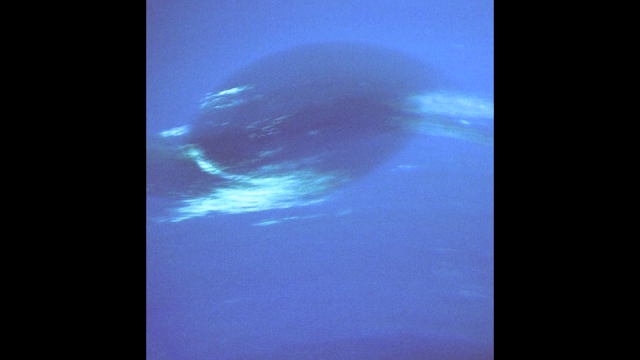Neptune is the eighth and farthest known planet from the Sun after the exclusion of Pluto from the planets category, it is a gas giant and is fourth largest planet in the Solar System. Neptune is the densest of all the gas giants in the Solar System and so even though it is slightly smaller than Uranus it is more massive. Like it’s neighbor Uranus, Neptune is mostly made of Hydrogen and Helium with traces of other materials and ices like water, ammonia and methane and because of this composition Neptune is sometimes referred to as an Ice Giant like Uranus. While Uranus has a hazy mostly unremarkable atmosphere, Neptune has active and easily visible weather patterns which gives it a more distinctive appearance.
 |
| Neptune(right) compared to Uranus(left) |
Like Uranus, Neptune has methane in it’s atmosphere which gives it a blue color, However Neptune appears a darker blue than Uranus and the reason behind that is still not known. When Voyager-2 spacecraft flew by Neptune in 1989, the planet had a Great Dark Spot much like The Great Red Spot on Jupiter, but in 1994 that spot had disappeared completely.
 |
| The Great Dark Spot which has now disappeared |
Neptune has the strongest winds of any planet in the Solar System with speeds recorded as high as 1300 miles or 2100 kilometers per hour. Neptune is also one of the coldest places in the Solar System with atmospheric temperatures of about negative 360 degree fahrenheit or negative 218 degree celsius. Neptune was the first planet to be discovered through mathematical predictions instead of being seen as it is too faint to be observed with the unaided eye. As early as 1821, astronomer Alexis Bouvard noticed that Uranus’s orbit was behaving in a way that could best be explained by the gravity of another planet tugging on it. In 1843, John Couch Adams calculated where the orbit of this mysterious eighth planet would be but nothing came out of it, 3 years later in 1846 French mathematician Urbain Le Verrier made his own calculations and convinced German astronomer Johann Gottfried Galle to search for the undiscovered planet which he spotted on October 23rd 1846.
The newly discovered planet was named Neptune after the Roman god of the sea probably because of it’s deep blue color, the name of the Roman mythology was chosen to match the names of other planets of the Solar System. Neptune is nearly 2.8 billion miles or 4.5 billion kilometers from the Sun and because it is so far, it takes an incredibly long time to complete one orbit around the Sun which is almost 165 Earth years. From the time it was discovered in 1846 Neptune did not complete one full orbit until 2011 and it will not complete it’s next orbit until 2176.
 |
| This is how the orbits of Pluto and Neptune intersect |
Another interesting fact about Neptune’s orbit is the way it intersects with Pluto’s orbit, Because Pluto’s orbit is so irregular it crosses inside of Neptune’s path for 20 years of every 248. Between 1979 and 1999, Pluto was actually closer to the Sun than Neptune, something that will not happen again for more than 200 years. Neptune has a system of six known rings, although they are so faint that they were not discovered until 1968, Neptune’s rings are unusual and in that they are not smooth and even like the rings of other planets but are instead distributed in an uneven clumps of dust and ice.



